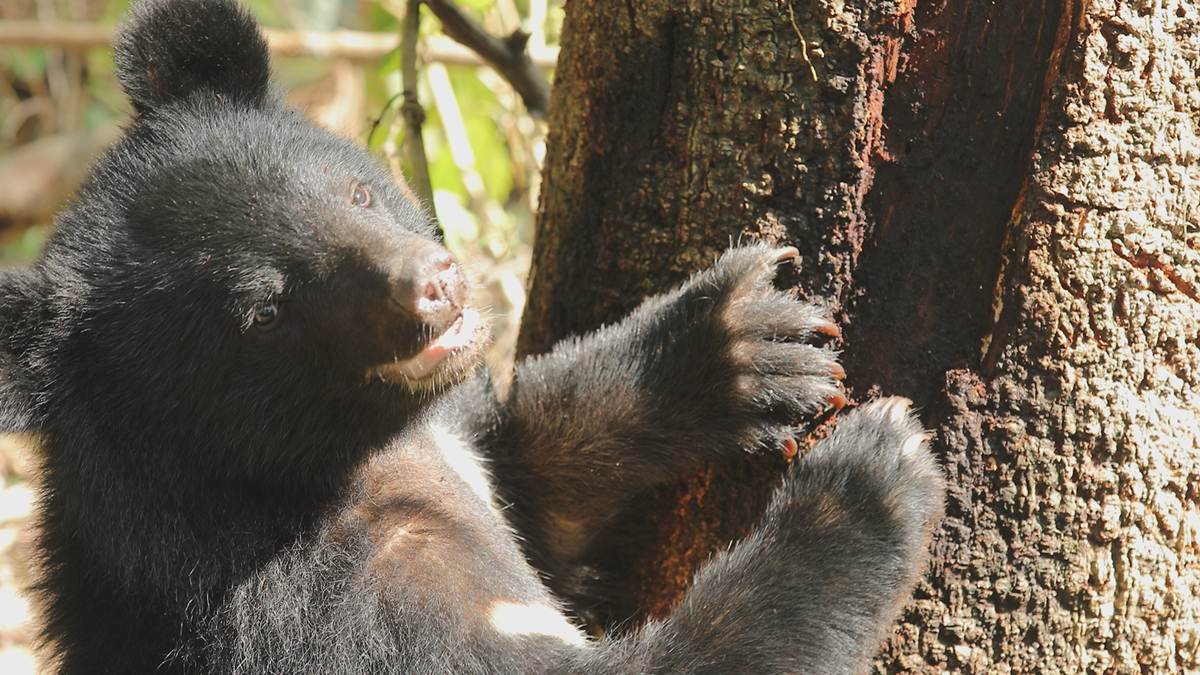Award-winning Documentary Series “Made In Taiwan”
Eleven Years on the Mountain: Hunting the Elusive Formosan Black Bear

Source:Barley Productions
How do you shoot that which you cannot see? Capturing images of the elusive Formosan black bear is tougher than filming the polar bears you see on Animal Planet.
Views
Eleven Years on the Mountain: Hunting the Elusive Formosan Black Bear
By Ching I Chenweb only
How do you shoot that which you cannot see? Capturing images of the elusive Formosan black bear is tougher than filming the polar bears you see on Animal Planet. The forest-dwelling Formosan black bear has an acute sense of smell and can elude humans without even being seen. Jue-Ming Mai (麥覺明), director of the award-winning documentary series “Made In Taiwan” (MIT台灣誌), was no stranger to the spellbinding beauty of Taiwan’s forests and mountains. He became obsessed with capturing footage of the Formosan black bear. He spent eleven years working with scientists and tracking the bears over rivers and fields in the depth of Taiwan’s mountains. Mai has been up and down the mountains over a hundred times, all to pierce the veil and catch a glimpse of Taiwan’s majestic mountain giants.
“BB! Director Mai, BB!” A mysterious cry is heard on the other side of the mountain. The filming crew has been on the Batongguan Japanese Era Crossing Trail (八通關越嶺古道) for a month. They are out of food and blank tapes to record on. Director Jue-Ming Mai (麥覺明) was just about to lead the team off the mountain, but now everyone is doubling back in a hurry, because “BB” has been sighted.
Of course, “BB” stood for “Black Bear.” It is the Formosan black bear, the mysterious giant of Taiwan’s mountains.
The entire month of waiting was only for a small segment of the entire documentary. But Director Mai, creator of the acclaimed television program “Made In Taiwan” (MIT台灣誌), has been waiting for the black bear for eleven years.
“I’ve been hiking Taiwan’s mountains since I was a student. It’s been over thirty years, but I never once saw the Formosan black bear out in the wild,” says Mai. While he’s no stranger to the beauty of Taiwan’s mountains and forests, the fact he’s never been able to pierce the veil and capture an image of this elusive phantom has never been far from his mind. You might say the black bear became his white whale.
Bravo the Mascot Bear Is Not A Real Bear
It’s common knowledge that pandas eat bamboos and koalas eat eucalyptus leaves. Do you know what the Formosan black bear eats? Bonus points if you didn’t have to search Google for the answer.
We know the bears reside in the mountains, but which mountain, exactly? Taiwan’s knowledge of its precious black bears mostly comes from the mouths of wizened village elders. Even the population and habitat of the bears is a mystery to modern man.
In 2008, Mai started working with the research team led by scientist Mei-Hsiu Hwang (黃美秀), known by the local tribes as “Ali-Duma”, mother of black bears. That was when his quest for the Formosan black bear began. In his search for the elusive creatures, Mai’s team had to go up the Laonong River (荖濃溪) to reach the major settlement of Yusuei She (玉穗社). They had arrived in bear country.
“This is a journey without end.” The crew’s fears and doubts were on full display. The hiking trails they were used to at least had markers along the way. But the search for wild animals has led them onto paths seldom traversed by human feet.
There was an old suspension bridge being supported by a single iron cable. There were large swathes of the cliffside that had collapsed. The crew carried heavy filming equipment to ancient tribal dwellings that did not even have what you’d call a foot trail. The broken mountain paths caused many a tumble as the crew struggled deeper into the wilderness. Just watching footage of their progress makes you feel exhausted. “What we ate, what we wore, where we stayed and where to go—all that depended on the mercy of heaven. Whatever kind of weather or terrain God gave us, we had to surmount that.” Mai says straightforwardly. They knew what they were there for. In the search for the black bear, even the mark of bear claws or the remnant of bear droppings was a treasure to be coveted.
A Documentary Where the Lead is a No-show
Dangerous terrain and unpredictable weather may be par for the course for travelers on the mountain. Mai’s biggest challenge in making his documentary about black bears was very simple: “We could not find any!”
A documentary about bears without the footage of bears is like a wedding without a bride. “Where are the black bears?” This question haunted Mai’s team for the past eleven years.
In 2014, the filming crew entered the mountain regions of Dafen (大分) to record the progress of Huang’s catch and release program. A large area of ring-cupped oak had come into maturity over the autumn and winter. This was the Formosan black bear’s favorite food, so it seemed to make sense to await their visit in this gastronomic paradise. This was their best shot at finding samples and observing the bears in their natural habitat.
A visit to the bears’ home is no walk in the park. It takes three days to go up the mountain and two days to come back down. The research team set up non-harmful bear traps to await the arrival of the mysterious black bears.
Before they knew it, all the bait had been gobbled up, and still there was no sight of the bears.
No one knew when the black bear would show up. All they could do was wait.
They waited so long that they harvested a batch of tomatoes in their makeshift garden.
“We stayed so long on the mountain, the tomato seeds we planted grew into tomatoes,” remembers Gui Qiong Ruan (阮桂瓊), the director at Barley Productions (大麥影像傳播工作室). The team ate wild guavas as they waited to see the bears.
It might sound like a fine vacation to plant tomatoes and eat wild guavas while hoping for black bears to show up. But money was burning up fast. And new episodes of their television program were still being aired every week back in the civilized world.
Did you ever doubt yourself or what you were doing?
Mai smiles at the question. “Yes.” His staff were paid by the day. A “leisurely wait” was a huge expenditure in the accounting books.
To expedite their capture of footage of black bears, the team set up around twenty infrared cameras in areas where the bears might be active.
Every few weeks, they went up the mountain to put in fresh batteries and blank tapes. Mai describes the feeling of anticipation each time: “Just listening to the sound of black bears sniffing the camera makes me feel physically closer to these creatures.”
Many times, while the team was away shooting in Kaohsiung or Hualien, they would be notified of a possible sighting of the black bears. Everyone would come hurrying back to set up their equipment. Everything was put on hold. The crew raced up the mountain to rendezvous with Huang’s research team.
“We never thought of doing things the easy way,” says Ruan. “If Director Mai wants to do something, he will not stop until it is done.”
In the end, the eleven years paid off. From the rough trailblazing days when the team mapped out the black bears’ habitat, to the catch and release program in the mountains of Dafen and Dasyueshan (大雪山), the crew made friends with all kinds of black bears. There was a clever and tenacious honey thief who never got caught. A bear who came to find a dentist because of a toothache. And then there was the female bear cub found near Nanan Falls in Hualien (南安小熊妹仔), whose journey home enthralled the nation. The people of Taiwan learned more and more about their ursine neighbors.
Black Bear Research and Conservation Face the Challenge of Cost and Inaccessibility
The movie “Formosan B.B. is Coming” (黑熊來了), set to premiere on December 13th, documents the team’s eleven years of work on this project. Contained within these two hours of film are rare footage of the majestic black bears, beautiful shots of Taiwan’s primitive forests, and the parallel space above our heads: the mountain regions at an altitude of one to two thousand meters.
“There is only one species of bear in Taiwan; they came to our island during the Ice Age of the distant past,” Mai’s narrative connects the coming of the Formosan black bear with Taiwan’s history. According to Huang’s estimate, there are only two to six hundred Formosan black bears left in Taiwan. Mai worries: “If one day the black bear goes away, we’ll be in trouble.”
Professor Yu-Ten Ju (朱有田) of the Department of Animal Science and Technology at the National Taiwan University (台灣大學動物科學技術學系) highlights the difficulty of studying and preserving the Formosan black bear. Funding is limited, making it difficult to sustain any long-term project. The high mountains and deep valleys of Taiwan also restrict the mobility of research teams. All these challenges make it hard to find field researchers and technology in this particular field of study.
“How can we talk about sustainability or preservation without first doing research?” says Ju. “For example, the appearances of the ‘Litu’ cub (利稻小熊) and the ‘Mulas’ cub (廣原小熊) beg the question: are they showing up because there is an increase of black bears in that location? Or is there a human element involved? If we don’t have empirical data, we have no way to say if they (the black bears) are increasing in number or not.”
The entire documentary is unscripted. “All we had to count on was our luck and our dedication,” Mai says lightly. Eleven years of grueling work produced two hours of film for the world’s viewing pleasure.
How much money was spent along the way? Mai says he lost count. Everyone told him shooting a film was expensive, especially an unconventional film such as this one. “If we break even, that’d be an achievement,” says Ruan.
Perhaps spend a little more on marketing, or try that newfangled thing called crowdfunding? After all, the Formosan black bear is Taiwan’s most popular mascot. The audience should be glad to pay for merchandise tie-ins?
“We didn’t do any of that (crowdfunding),” says Mai. His mission is simple: “I hope that through imagery, everyone can learn more about this piece of earth we live on called Taiwan.”
He didn’t think about much beyond that, and he didn’t think about how long the shooting will take. He just went ahead and did it. “As long as the audience can see the adorable black bears and Taiwan’s beautiful scenery, I think this film is worth sharing.” He simply wants to inspire more caring and concern from the people by fulfilling his dream of making a documentary about our ecology.

Like Mai said, he’s been hiking up mountains for over thirty years, but he’s never had a close encounter with a black bear. Finally, as shooting for his documentary wrapped up this year, he got his wish. On the Sinkang Hiking Route (新康橫斷) that led off the mountain, about thirty or fifty meters in front of him, he saw a black bear cub. The sight of the immature little cub slowly jogging off “really filled me with joy.”
The Formosan black bear has really arrived.
Have you read?
♦ Taiwan's Global Noah’s Ark of Plants
♦ Taiwan’s First Professional Underwater Cetacean Photographer
♦ Wildlife Repatriating - Taiwan, Once Dubbed as 'Diewan', Has Come a Long Way
Translated by Jack C.
Edited by Sharon Tseng












